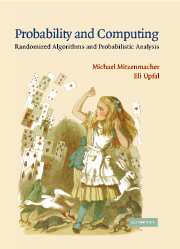Book contents
- Frontmatter
- Contents
- Preface
- 1 Events and Probability
- 2 Discrete Random Variables and Expectation
- 3 Moments and Deviations
- 4 Chernoff Bounds
- 5 Balls, Bins, and Random Graphs
- 6 The Probabilistic Method
- 7 Markov Chains and Random Walks
- 8 Continuous Distributions and the Poisson Process
- 9 Entropy, Randomness, and Information
- 10 The Monte Carlo Method
- 11 Coupling of Markov Chains
- 12 Martingales
- 13 Pairwise Independence and Universal Hash Functions
- 14 Balanced Allocations
- Further Reading
- Index
7 - Markov Chains and Random Walks
- Frontmatter
- Contents
- Preface
- 1 Events and Probability
- 2 Discrete Random Variables and Expectation
- 3 Moments and Deviations
- 4 Chernoff Bounds
- 5 Balls, Bins, and Random Graphs
- 6 The Probabilistic Method
- 7 Markov Chains and Random Walks
- 8 Continuous Distributions and the Poisson Process
- 9 Entropy, Randomness, and Information
- 10 The Monte Carlo Method
- 11 Coupling of Markov Chains
- 12 Martingales
- 13 Pairwise Independence and Universal Hash Functions
- 14 Balanced Allocations
- Further Reading
- Index
Summary
Markov chains provide a simple but powerful framework for modeling random processes. We start this chapter with the basic definitions related to Markov chains and then show how Markov chains can be used to analyze simple randomized algorithms for the 2-SAT and 3-SAT problems. Next we study the long-term behavior of Markov chains, explaining the classifications of states and conditions for convergence to a stationary distribution. We apply these techniques to analyzing simple gambling schemes and a discrete version of a Markovian queue. Of special interest is the limiting behavior of random walks on graphs. We prove bounds on the covering time of a graph and use this bound to develop a simple randomized algorithm for the s–t connectivity problem. Finally, we apply Markov chain techniques to resolve a subtle probability problem known as Parrondo's paradox.
Markov Chains: Definitions and Representations
A stochastic processX = {X(t): t ∈ T} is a collection of random variables. The index t often represents time, and in that case the process X models the value of a random variable X that changes over time.
We call X(t) the state of the process at time t. In what follows, we use Xt interchangeably with Xt. If, for all t, Xt assumes values from a countably infinite set, then we say that X is a discrete space process. If Xt assumes values from a finite set then the process is finite.
- Type
- Chapter
- Information
- Probability and ComputingRandomized Algorithms and Probabilistic Analysis, pp. 153 - 187Publisher: Cambridge University PressPrint publication year: 2005



